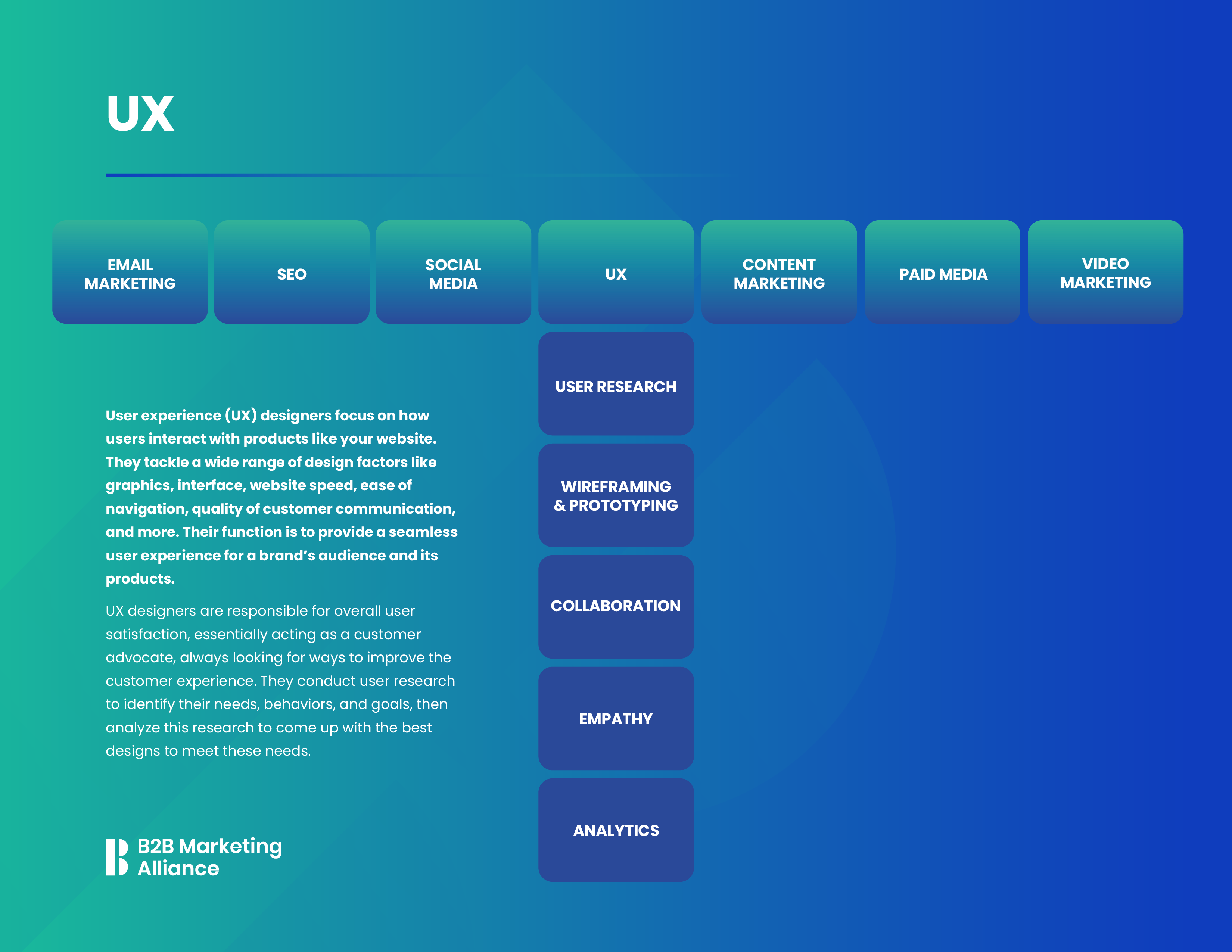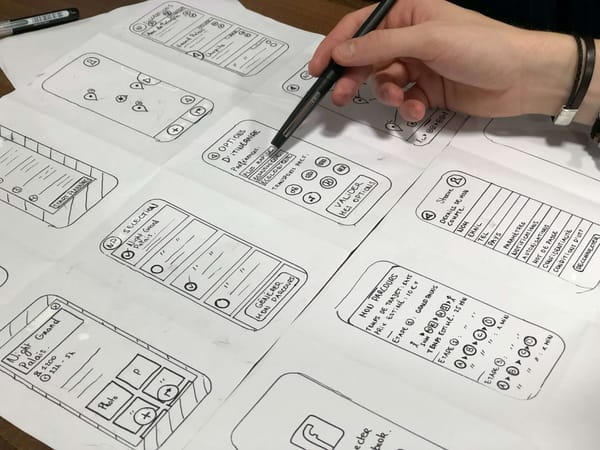Honing your skills as a marketer means expanding outside of your usual skillset and the comfort zone of your niche. To become a truly well-rounded marketer, your general marketing knowledge needs to be expanded across the different marketing disciplines.
This is known as becoming a t-shaped marketer.
A t-shaped marketer is a marketer with a specific specialty in marketing, like content, SEO, or UX design, that has developed a wide range of skills that extend into other areas of marketing. They can pull from the deep well of knowledge they have in their specific field to help out the entire marketing team, regardless of the task at hand.
To learn more about how you can become a t-shaped marketer, download our t-shaped marketer playbook!
Skills needed to be a t-shaped UX designer
User experience (UX) designers focus on how users interact with products like your website. They tackle a wide range of design factors like graphics, interface, website speed, ease of navigation, quality of customer communication, and more. Their function is to provide a seamless user experience for a brand’s audience and its products.
UX designers are responsible for overall user satisfaction, essentially acting as customer advocates, always looking for ways to improve the customer experience. They conduct user research to identify their needs, behaviors, and goals, then analyze this research to come up with the best designs to meet these needs.

User research
Research is crucial for determining user needs and how they will use and interact with a finished product. So a successful UX designer needs to know all the different research methods, like qualitative and quantitative data collection, how to conduct their research, and how to analyze the findings.
- Qualitative research
Using methods like interviews to gain a deeper understanding of why users do what they do. You may ask users open-ended questions to get personal insights into how they use your products. It’s a great way to gain specific insights, but the results are non-numerical data, so personal opinions can impact the findings.
- Quantitative research
A more structured research method like surveys and analytics to gather data about what users do in terms of using your products or services. With a large enough sample of representative users, you have a statistically reliable way of making assumptions about your target user base.
Wireframing and prototyping
Creating wireframes and prototypes is a key component of every UX designer’s skillset. Wireframes and prototypes allow UX designers to test their ideas, showing a simulation of the final product that can be tested and used to gather feedback.
Testing in this way enables misunderstandings and mistakes to be identified and addressed as early on in the design process as possible. Whether done as a sketch on paper to get a sense of user flow or a digital hi-fi prototype, it’s a cost-effective way to identify needed changes before embarking on a finished build, where any changes would be more difficult and expensive to implement.
Collaboration
UX designers work alongside many people to implement their designs, so you need incredible collaboration skills. UX designers will add ideas from team members and clients, so being able to collaborate effectively allows you to proactively implement feedback, negotiate on requirements, and build on the ideas of others.
Empathy
Empathy is a key factor when working with user-centric design. UX designers are advocates for the users, so they need to be able to put themselves in their shoes and view the product through their eyes. They need to be able to pick up on pain points and understand what the end goal is for the user when using the product. Empathy helps UX designers make better design decisions, and this empathetic mindset and approach can ensure the right solutions are implemented into the final design.
Inside, discover how to level up across social, content, SEO, email, UX, and more.
The path to becoming an unstoppable T-shaped marketer is just one click away: Get your copy here! 💫
You need to create as many opportunities as you can to learn more about how users use your products so that you can gather insights and gain a well-rounded picture of how your product is perceived. Make use of customer feedback, as these discussions can reveal a lot about how your product impacts users in ways that usability testing simply can’t.
Analytics
Once an app or website is built, UX designers need to know how well it performs. Analytics is ideal for this, so UX designers need to know how to interpret the data so they can understand the performance of their design. Applying the data can help UX designers iterate better designs backed by real user numbers.
UX analytics can help you test and confirm hypotheses, like why users aren’t clicking on a particular button, or why users are leaving the site without finding what they need. You can use tools like website usage analytics, user flow maps, real-time analytics, and heatmap analytics to gather different types of data for your analysis.
How UX impacts other forms of marketing
Email is an integral part of a customer’s user experience, as it’s one of the most direct ways customers have regular contact with your brand. It’s just as crucial that any email marketing efforts are optimized for UX alongside your website.
Email provides an effective look at what kind of content is most popular with users, by looking at which emails generate the most click-throughs. From a UX perspective, you can use this data to gain a better understanding of what sort of content should be the most prominent on your landing pages.

SEO
SEO is used to help boost your site up the search engine rankings to become more visible, but once someone lands on your site, UX comes into effect to help answer their questions faster and provide them with what they need.
Poor SEO hurts the UX of your website, as you won’t be getting relevant visitors who actually want to engage with your services. As a UX designer, you need to balance good SEO on your site without treading into bad SEO practices like keyword stuffing.

Social media
Social media can be a great tool for UX designers doing discovery research. Social media is an incredible source of data that can help UX designers answer questions throughout product development. You can gather and analyze data to improve usability and better understand the needs of your audience, revealing their pain points that can then be addressed.
Social media makes the perfect tool for identifying the specific experiences of the people using your products and services, and once you understand any problems and issues, you can offer solutions.

Content
Aside from usability, a broader aim for UX is to ensure users are satisfied with the content, features, and function of the site. So without great content, user needs aren’t being fully met, even with perfect usability. UX houses and positions the content for users, creating the structure, design, and architecture that facilitates the content.

Paid media
The job of paid media is to get users to click through their ads onto landing pages. So when UX works alongside this department, you can create a truly cohesive experience for the user in terms of ad messaging.
Different channels are more connected than ever, so UX needs to work with departments like paid media to ensure the brand’s presence online is always consistent and relevant to the user. Split testing creatives, landing pages, and funnels, is vital to decreasing the cost per acquisition.
People are not keen on ads, so they need to be relevant and engaging, which is where UX can come in and ensure paid media go beyond a great campaign targeting strategy and make a truly holistic ad experience for their audience.

Video
The main function of video in a user interface is presenting information in a way that’s clear and easy to understand. A one-minute video can share a chunk of information, often in a more succinct way than a block of text or with screenshots, which is why video can create a better user experience with the likes of tutorials and guides.

Final thoughts
When you develop your marketing skills, you not only facilitate more successful marketing campaigns, but by expanding your marketing skills in all other areas, you can provide valuable insights and knowledge from your unique perspective as a UX designer, improving processes across the business.




 Follow us on LinkedIn
Follow us on LinkedIn



